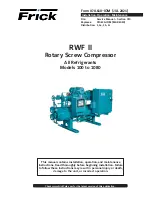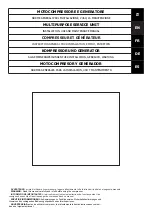
47
5. INSTALLING AND PIPING THE DSP [Ventilation of Air Compressor Room]
5.5 Ventilation of Air Compressor Room
●
Stop the ventilating fan when the air compressor has stopped.
●
The ventilating fan should be running while the air compressor is operating. If the ventilating fan is not running, the loss of air
flow may reduce the performance of the cooler.
●
The duct should be detachable for ease of maintenance on the air compressor.
CAUTION
Provide a ventilating system to the air compressor room in the event that the room temperature exceeds
the allowable ambient operating temperature of 104
℉
(40
℃
). Operating the air compressor at an
ambient operating temperature above 104
℉
(40
℃
) may cause a serious problem.
①
Air intake opening
Provide the air compressor room with an enough air
intake opening that:
-
is positioned as low as possible on the wall.
-
is located in an environment free of external dust
and harmful material.
②
Ventilation without Duct (Figure A)
For ventilation without an exhaust duct, install a
ventilating fan with the specified capacity shown in
the
Recommended Ventilation Fan
①
or more row
in the table. The specified capacity is based on the
allowable room temperature rise of 9
℉
(5
℃)
.
Position of the ventilating fan is as high as possible on
the wall.
③
Ventilation with Duct and without Ventilating
Fan (Figure B)
●
For ventilation with an exhaust duct, calculate the
duct’s pressure loss based on information shown in
the Air Exhaust (Air Compressor) row in the table. If
the calculated pressure loss is less than 0.08 inchAq
(20 Pa), a ventilating fan is not required on the duct.
Install the duct with its detachable end directly in
contact with the grilled air exhaust on top of the air
compressor.
●
If the calculated duct’s pressure loss is 0.08 inchAq
(20 Pa) or larger, a ventilating fan is required on the
duct. Install the duct, keeping a gap “h” of 8 to 12
inches (200 to 300 mm) between the duct and the
grilled air exhaust on top of the air compressor. On
the other end of the duct, install a ventilating fan with
the specified capacity shown in the
Recommended
Ventilation Fan
②
or more row in the table.
(Fig. C)
●
Pay attention to the duct opening location. Noise may
be transmitted to outside through the duct. Provide
the noise absorbing material inside the duct if
required.
h
Air intake
opening
Fig. A
Fig. B
Fig. C
Ventilating fan
See “Recommended
fan capacity
①
” in
the table.
Ventilating fan
Shall be
removable.
Exhaust
duct
Ventilating fan
See
“Recommended
fan capacity
②
” in
the table.
Exhaust
duct
Air intake
opening
Air intake
opening
Exhaust
air
Exhaust
air
Exhaust
air
5.5.1 Air-Cooling Type
Air-Cooled
IMPORTANT
Technical Data for Room Ventilation
Model
Item/Unit
45ATN
55ATN
55VATN
75AN
75VATN
Heat
generation
KBTU
188
233
316
(MJ/h)
(198)
(246)
(333)
Air compressor
exhaust
cfm
5300
5300
7060
(m
3
/min)
(150)
(150)
(200)
Exhaust air
temperature rise
℉
Approx. 36 Approx. 45 Approx. 45
(
℃
)
(Approx. 20) (Approx. 25) (Approx. 25)
Exhaust duct allowable
pressure loss
inchAq
0.08
(Pa)
(20)
Recommended
fan capacity
①
cfm
18720
22960
31430
(m
3
/min)
(530)
(650)
(890)
Recommended
fan capacity
②
cfm
6360
6360
8120
(m
3
/min)
(180)
(180)
(230)
















































